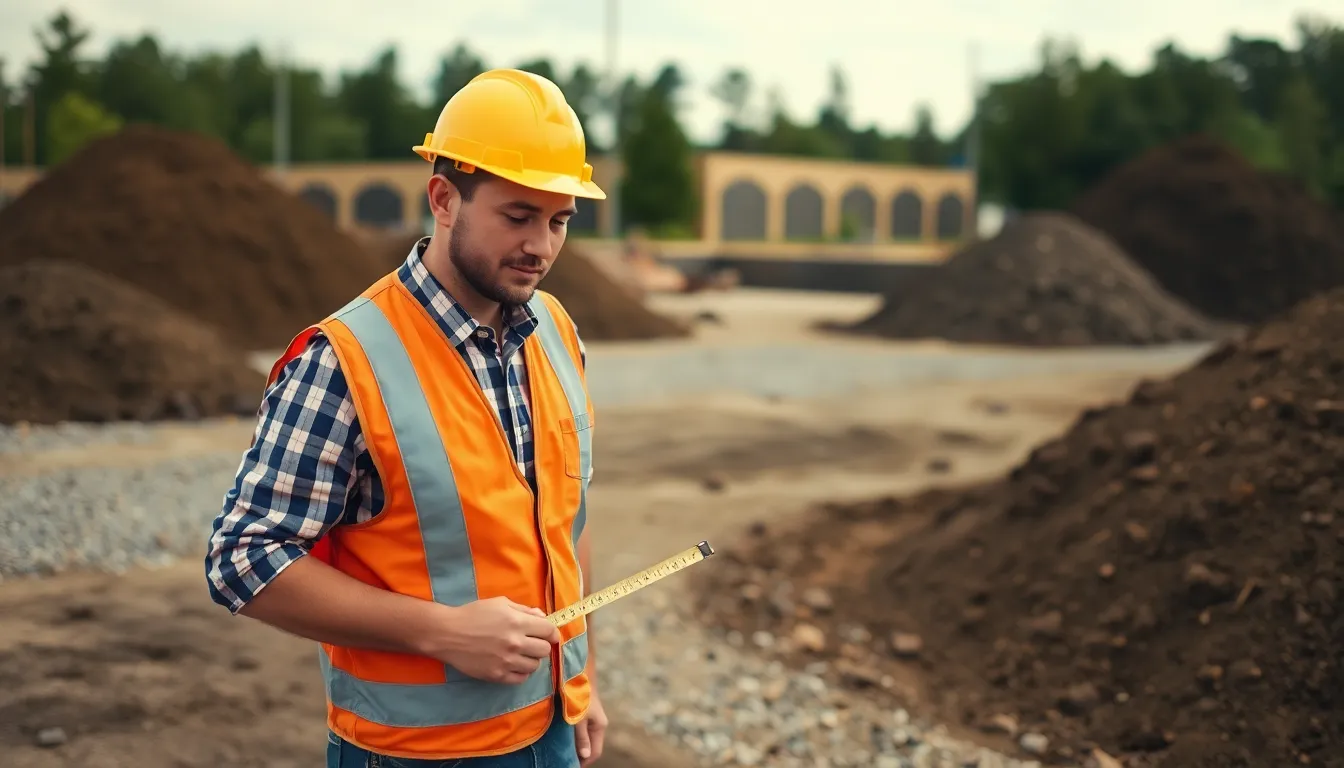Table of Contents
ToggleWhen it comes to construction or landscaping, understanding the difference between square yards and cubic yards can feel like deciphering a secret code. Imagine trying to fill a swimming pool with a garden hose while calculating how many square yards of sod you need—it’s enough to make anyone’s head spin! But fear not, because converting square yards to cubic yards isn’t rocket science; it’s more like a fun math puzzle that just needs a little nudge in the right direction.
Understanding Square Yards and Cubic Yards
Square yards and cubic yards serve different purposes in construction and landscaping. Grasping their distinct definitions aids in making accurate measurements.
Definitions of Square Yards
Square yards measure a two-dimensional area. One square yard equals the area of a square with each side measuring one yard. This unit plays a crucial role in flooring, landscaping, and similar projects. Common applications include calculating the area needed for grass, tiles, or carpets. When dealing with larger spaces, such as a lawn, square yards simplify the measurement process, ensuring accurate estimations are made.
Definitions of Cubic Yards
Cubic yards measure volume and represent a three-dimensional space. A cubic yard equals the volume of a cube with sides measuring one yard. This measurement is vital for estimating materials like concrete, soil, and mulch. Using cubic yards helps determine the amount needed for construction projects or landscaping enhancements. When planning a project, converting square yards into cubic yards becomes essential to find out how much material will fill a specified area.
Converting Square Yards to Cubic Yards

Converting square yards to cubic yards involves understanding area and volume. This conversion is essential for construction and landscaping projects for accurate material measurements.
Importance of Conversion
Conversion from square yards to cubic yards remains critical for ensuring correct supply calculations. Estimating the amount of soil or concrete necessary for filling areas relies on this conversion. Projects such as pouring foundations or creating garden beds depend heavily on these calculated volumes. Knowing how to convert can prevent costly material shortages or overages. Accurate conversions also aid in project budgeting, enabling precise financial planning. Clarity in measurements contributes to better project outcomes and reduces waste.
Factors Affecting Conversion
Several factors affect square yard to cubic yard conversion accuracy. First, the depth of the area significantly influences total volume calculations. A flatter area may yield different results compared to one with a greater depth. Additionally, the type of material used can impact how much fits within a specified area. Compressed materials like gravel require different considerations compared to loose materials like topsoil. Weather conditions can also affect moisture content, influencing the final volume. When converting, always consider these variables for precise estimations and effective planning.
Practical Applications
Understanding square yards and cubic yards proves beneficial in various contexts, notably in landscaping and construction. Accurate area measurements play a crucial role in determining the necessary materials. For instance, when laying sod or paving a driveway, knowing the square yard measurement ensures sufficient coverage. Converting these measurements to cubic yards helps calculate soil volume for garden plots or foundations, preventing shortages during project execution.
Landscaping and Construction
Landscaping projects often require precise measurements. Professionals utilize square yards to assess lawn area or flower beds. Accurate calculations enable them to order the correct amount of topsoil or mulch. Cubic yards come into play when calculating material needed for planting beds or hidden drainage systems. Every cubic yard measurement translates into a specific volume of soil or gravel required for optimal plant health.
Volume Calculations
Cubic yards factor into numerous volume calculations, particularly in construction. For concrete pouring, calculating cubic yards ensures sufficient material for slabs, walls, and other structures. Construction teams rely on these calculations to produce strong bases, preventing overages or shortages. For landscape features like retaining walls, knowing the volume provides insight into stone or block requirements. Each cubic yard calculated aids in project planning and cost assessment, leading to smoother execution.
Common Mistakes to Avoid
Understanding the differences between square yards and cubic yards helps prevent costly mistakes in construction and landscaping projects. Recognizing common errors enhances project accuracy and efficiency.
Misunderstanding Area vs. Volume
Confusion often arises when individuals equate area with volume. Square yards quantify a flat surface, while cubic yards measure three-dimensional space. Projects involving flooring require knowledge of square yards, yet soil calculations rely on cubic yards. Failing to grasp this distinction leads to incorrect material estimations. Familiarity with the two measurements aids in making informed decisions. Accurate understanding ensures the right quantities are ordered for a job, avoiding both shortages and surpluses.
Errors in Measurement
Measurement mistakes frequently occur during project planning. Relying on incorrect tools results in inaccurate data. Using tape measures that are worn or miscalibrated can contribute to errors. It’s crucial to double-check each measurement for precision. Furthermore, neglecting to account for depth in cubic yard calculations can lead to significant discrepancies. Small variations in measurements impact material needs. Taking time to verify area and volume measurements ensures accurate project outcomes. Careful assessment reduces waste and saves money in the long run.
Understanding the distinction between square yards and cubic yards is crucial for successful construction and landscaping projects. Accurate measurements ensure that materials are ordered correctly and that projects stay within budget. By grasping these concepts and applying the right conversions, individuals can avoid costly mistakes and enhance project efficiency.
Taking the time to verify measurements and consider factors like depth and material type leads to better planning and reduced waste. With the right knowledge, converting between square yards and cubic yards becomes a straightforward task that can significantly impact the outcome of any project.





